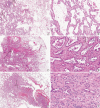The new 2011 international association for the study of lung cancer/american thoracic society/european respiratory society classification of lung adenocarcinoma in resected specimens: clinicopathologic relevance and emerging issues
- PMID: 24009626
- PMCID: PMC3759630
- DOI: 10.4132/KoreanJPathol.2013.47.4.316
The new 2011 international association for the study of lung cancer/american thoracic society/european respiratory society classification of lung adenocarcinoma in resected specimens: clinicopathologic relevance and emerging issues
Abstract
Pathologists play an increasingly important role in personalized medicine for patients with lung cancer as a result of the newly recognized relationship between histologic classification and molecular change. In 2011, the International Association for the Study of Lung Cancer/American Thoracic Society/European Respiratory Society (IASLC/ATS/ERS) proposed a new architectural classification for invasive lung adenocarcinomas to provide uniform terminology and diagnostic criteria. This review highlighted the evolution of the classification of lung adenocarcinomas in resected specimens with special respect to both histologic subtyping and invasion. Histologic subtyping of lung adenocarcinoma has been updated based on five major predominant patterns. New concepts of adenocarcinoma in situ and minimally invasive adenocarcinomas have been introduced to define the condition of patients who are expected to have excellent survival. Although the new IASLC/ATS/ERS classification has promising clinical relevance, significant clarification remains necessary for the definitions of subtyping and invasion. More precise definitions and subsequent better education on the interpretation of terminology will be helpful for future studies.
Keywords: Adenocarcinoma; Classification; Invasion; Lung; Subtyping.
Conflict of interest statement
No potential conflict of interest relevant to this article was reported.
Figures

Similar articles
-
The new IASLC/ATS/ERS lung adenocarcinoma classification from a clinical perspective: current concepts and future prospects.J Thorac Dis. 2014 Oct;6(Suppl 5):S526-36. doi: 10.3978/j.issn.2072-1439.2014.01.27. J Thorac Dis. 2014. PMID: 25349703 Free PMC article. Review.
-
Cytologic subtyping of lung adenocarcinoma by using the proposed International Association for the Study of Lung Cancer/American Thoracic Society/European Respiratory Society (IASLC/ATS/ERS) adenocarcinoma classification.Cancer Cytopathol. 2013 Nov;121(11):629-37. doi: 10.1002/cncy.21314. Epub 2013 Aug 13. Cancer Cytopathol. 2013. PMID: 23943235
-
Diagnosis of lung adenocarcinoma in resected specimens: implications of the 2011 International Association for the Study of Lung Cancer/American Thoracic Society/European Respiratory Society classification.Arch Pathol Lab Med. 2013 May;137(5):685-705. doi: 10.5858/arpa.2012-0264-RA. Epub 2012 Sep 12. Arch Pathol Lab Med. 2013. PMID: 22913371
-
Tumor invasiveness as defined by the newly proposed IASLC/ATS/ERS classification has prognostic significance for pathologic stage IA lung adenocarcinoma and can be predicted by radiologic parameters.J Thorac Cardiovasc Surg. 2014 Jan;147(1):54-9. doi: 10.1016/j.jtcvs.2013.08.058. Epub 2013 Oct 13. J Thorac Cardiovasc Surg. 2014. PMID: 24131786
-
New pathologic classification of lung cancer: relevance for clinical practice and clinical trials.J Clin Oncol. 2013 Mar 10;31(8):992-1001. doi: 10.1200/JCO.2012.46.9270. Epub 2013 Feb 11. J Clin Oncol. 2013. PMID: 23401443 Review.
Cited by
-
ROS1 gene rearrangement and copy number gain in non-small cell lung cancer.Virchows Arch. 2015 Jan;466(1):45-52. doi: 10.1007/s00428-014-1679-2. Epub 2014 Nov 6. Virchows Arch. 2015. PMID: 25374304
-
Tumor heterogeneity assessed by texture analysis on contrast-enhanced CT in lung adenocarcinoma: association with pathologic grade.Oncotarget. 2017 Feb 16;8(32):53664-53674. doi: 10.18632/oncotarget.15399. eCollection 2017 Aug 8. Oncotarget. 2017. PMID: 28881840 Free PMC article.
-
Clinicopathological and prognostic significance of metastasis-associated protein 1 expression and its correlation with angiogenesis in lung invasive adenocarcinomas, based on the 2011 IASLC/ATS/ERS classification.Oncol Lett. 2016 Jan;11(1):224-230. doi: 10.3892/ol.2015.3839. Epub 2015 Oct 29. Oncol Lett. 2016. PMID: 26870192 Free PMC article.
-
Characterization of a transgenic mouse model exhibiting spontaneous lung adenocarcinomas with a metastatic phenotype.PLoS One. 2017 Apr 18;12(4):e0175586. doi: 10.1371/journal.pone.0175586. eCollection 2017. PLoS One. 2017. PMID: 28419107 Free PMC article.
-
Myoferlin expression in non-small cell lung cancer: Prognostic role and correlation with VEGFR-2 expression.Oncol Lett. 2016 Feb;11(2):998-1006. doi: 10.3892/ol.2015.3988. Epub 2015 Dec 2. Oncol Lett. 2016. PMID: 26893682 Free PMC article.
References
-
- Boyle P, Levin B. World cancer report 2008. Lyon: International Agency for Research on Cancer; 2008.
-
- Jemal A, Siegel R, Xu J, Ward E. Cancer statistics, 2010. CA Cancer J Clin. 2010;60:277–300. - PubMed
-
- Travis WD, Brambilla E, Müller-Hermelink HK, Harris CC. World Health Organization classification of tumours: pathology and genetics of tumours of the lung, pleura, thymus and heart. Lyon: IARC Press; 2004.
-
- Yoshizawa A, Motoi N, Riely GJ, et al. Impact of proposed IASLC/ATS/ERS classification of lung adenocarcinoma: prognostic subgroups and implications for further revision of staging based on analysis of 514 stage I cases. Mod Pathol. 2011;24:653–664. - PubMed
Publication types
LinkOut - more resources
Full Text Sources
Other Literature Sources

